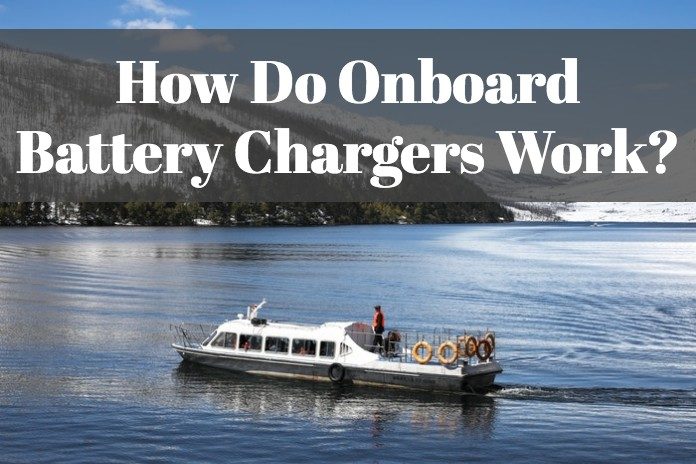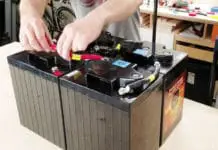
Onboard battery chargers are used for marine vehicles. It is an essential part of running and making the boat work. The whole electrical system depends upon the battery power. Having your onboard battery charger will help you get the sufficient energy load that you needed.
Buying your onboard charger will be the best thing you will ever do. You need to make sure that your built-in chargers are compatible with your marine battery.
So, how do onboard battery chargers work? An onboard battery charger is made up of one up to four battery chargers that our house in a single casing. A boat or marine vehicle does not bear an alternator, and it cannot charge like what outboard motors do.
Onboard battery charger charges your marine battery like no other. However, buy a charger that could equal the number of cells that you have in your boat.
Many are working and depending on the power of their marine batteries. It is challenging to get stalled in the middle of the water. So to always be ready, you should have your onboard battery charger with you all the time.
What Is An Onboard Battery Charger?
Onboard chargers will let you leave your batteries in the boat. You don’t have to hook any other thing for it to charge. You plug in its AC cord, the one that is attached to the charger. Onboard chargers are computer-controlled. Never have to worry about overcharging as it adjusts its charging rate to the battery as it gets charged.
What Is The Difference Between An Onboard Battery Charger And A Regular Charger?
Marine onboard chargers protect the marine battery. As I have mentioned on top, built-in chargers can be left with the battery. It will not overcharge because it is computer controlled. The battery adjusts to the charging temperature.
However, the regular chargers that we have today don’t have that technology yet. Therefore, if you charge a battery, you should monitor its charging status. There is a possibility that it will end up overcharging your cells.
How To Use An Onboard Battery Charger
In this age of the internet, the onboard charger is the in-thing. It is, in fact, a convenient and very accessible to most people of today. But how does an onboard charger works compared to a manually installed?
Onboard chargers are like batteries too. Some were too bulky, but the modern versions are already streamlined and compacted for easy use. Mostly, they have the same function despite the differences in size or portability.
Onboard chargers are installed with your marine batteries to help you charge your cells while going on a sea trip or undergo any marine operations.
Onboard chargers usually operate on these phases:
1. Bulk phase. This phase is where you can see the first return of the products. It all relates to the amount of amp or ampere. The burst that the onboard charger gives out to give the recharging amount needed by the battery.
2. Absorption Phase. It usually takes 20% of the recharge process under this phase. It is where the battery and the charger are smoothened to have a constant pace of power. Though it is not focused compared to the bulk stage, it may be considered as the recharging cycle part. The dangers of overcharging the battery may happen.
3. Float Phase. This phase does not refer to the water. It refers to the way that it describes the energy. During this point, The constant energy process the recharged stage to be ongoing. The continuous is built from the second phase.
Ways To Select An Onboard Battery Charger
The right way to guide you in choosing your onboard battery charger is to consider the two factors that will help you get your batteries working strong. Consistent and reliable power is what you need to keep your batteries working.
When you are at sea, you need a continuous power system to supply the accessories you have onboard like your fish finder, your lights, and other accessories to keep you comfortable during your voyage at sea.
A battery charger is essential to all marine users. It is a component that we need to start engines and to keep the electric grid running. It provides the lights and other accessories to the boat.
When you buy an onboard charger for a marine battery, you have to ensure that the charger you purchased will work perfectly fine with your cell. You need to consider a few aspects and a few considerations as well. We will discuss here are the concerns that you have to make in buying an onboard marine battery charger.
1. Marine Battery Specifications
One thing to consider in buying a marine battery charger is the full specifications of the marine battery that you are using. Think of the type of battery that you have onboard, the amp-hour rate, the capacity of the battery, and its voltage will all matter in choosing the right charger for your cells.
Knowing your battery will bring you the right charger with different options of the various charging process. It will allow you to give the needs of your charging process easily.
2. The Voltage Of The Charger Needed For The Batteries
The voltage of your charger depends upon the configuration of your boat. This is the minimum amount of energy that your charger can give. It is to make sure that the charger onboard has the capacity of charging the boat batteries properly.
The configuration of your boat is a crucial matter for your battery needs.
For example:
1. If your boat uses a 12V marine cell, a charger with a 12V will be enough.
2. If the craft has dual 12V batteries and they are arranged parallelly, you will need a charger with 12V.
3. If the 12V array is times two and the connection is made in series, a 24 V charger is required.
Remember that when you used a 24V cell on a 12V battery, it becomes hazardous to both the charger and the battery. It may be a fire hazard, which is an awful situation. Therefore, you need to be sure that the configuration of your boat’s battery will match the charger itself.
3. Marine Battery Amperage
Knowing the correct amperage of your marine battery is indeed vital before you proceed in buying the charger. The amp-hour rating of the battery will indicate the battery’s output. It will help you in determining the amperage of the particular charger you need.
The right way to know the electricity or the charger ampere is to use the charger in recharging your battery.
Only take at least 10% of the amp-hour rating of the battery from the value (original).
4. Weather Conditions
Marine batteries and onboard chargers’ premature failure may be a cause of the environmental conditions where it is placed. When you buy a built-in marine charger for boats, you need to ensure that the device will only get a very humid temperature and moisture levels.
The latest model of your chargers is made to be resistant to moisture and other weather effects. This charger is mounted on the compartment of the engine or in any different location. A waterproof marine battery is the only best option.
5. Smart Charging Features And More…
Considering the charger’s feature is as good as knowing the full specification of the battery. The Smart Chargers will erase the risk of damaging the battery and overcharging it.
It is indeed a costly and pricey investment, but having it with you during your sea trip is a great idea. Considering the factors that I mentioned above, you will be able to decide a lot better.
Find The Best Onboard Battery Charger From Amazon
I have gathered here the three best onboard battery from Amazon.com. This choice is based on the reviews of the buyers who have tried the item itself:
NOCO Genius GEN3 30 AMP 3-Bank On-Board Battery Charger
This onboard charger from NOCO is a 30 amp battery charger. It is used for charging three 12V batteries separately and can also maintain them. It can be safely different charger types of lead-acid batteries like wet, gel, deep cycle batteries, and AGM types. It ranges from 25 to 230 Ah.
It works with advanced safety protection that features a technology covering spark-proof, reverse polarity, and overcharging. With its waterproof and rugged construction, this charger can submerge up to 3 meters deep water with a rate of IP58 and 6P Nema.
Pros:
● It can be used safely for all type of lead-acid batteries.
● It is a 30 amp charger.
● It is submersible in a 3 meters deep water.
● It is spark proof.
● It has reverse polarity.
● It got you cover against overcharging.
Cons:
● It can produce cancer and reproductive problems.
Product Specification:
Brand: NOCO
Model: GEN3
Item Weight: 16.7 pounds
Product Dimension: 14 x 12 x 7 inches
Voltage: 12 V
Minn Kota Mk 300D On-Board Battery Charger
This MK 300D onboard charger is water and shockproof. It is also vibration resistant. It is built in aluminum, so it is saltwater tested and resistant to corrosion.
It is protected against reverse polarity and short circuits. It is the kind of charger that you can use for a 12V flooded battery. It is also maintenance free and compliant to FCC.
Pros:
● It is water and shockproof.
● It is vibration resistant.
● It has protection against short circuit, reverse polarity, and ignition.
● It is a 12 V charger.
Cons:
● Warranty issues.
Product Specification:
Brand: Minn Kota
Model: 330 D
Item Weight: 13.5 pounds
Product Dimension: 18 x 8 x 7 inches
Marino On-Board 20 Amp Battery Charger Bank
Marinco On Board charger has a total of 20 amps, with an input voltage of 120/230V and an output voltage of 12V. A microprocessor for correct charging also controls it. It can charge AGM and flooded cells.
For easy assembly, the charge plug is connected to an Inlet without the use of wiring. It is one of the chargers that meet the standards of the global industry. It is also a waterproof charger.
Pros:
● A microprocessor controls it.
● It can connect easily to an inlet for easier assembly.
● It meets the standards of the global industry.
● It charges Flooded and AGM batteries.
● It is waterproof.
Cons:
● Charger failed after a few months.
Product Specification:
Brand: Marinco
Model: 20 amp battery charger
Item Weight: 11.2lbs
Product Specification: 12.6 x 16.3 x 3.7 inches ; 10.7 pounds
Having said the individual specifications of each onboard battery chargers, you now have a bright idea on how do onboard battery chargers work. You may have realized now how important it is to have an onboard chargers for your marine chargers.





